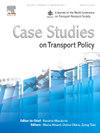Transportation accessibility for people with disabilities: Examining preferences for conventional public transport and ride-hailing services in Indonesia
IF 2.4
Q3 TRANSPORTATION
引用次数: 0
Abstract
Transportation is essential for facilitating economic, social, and political interactions by supporting population mobility, and ensuring accessibility is central to both mobility equality and social justice. In this context, people with disabilities (PwD), the world’s largest minority group, face significant barriers in accessing transportation, making it crucial to understand their transportation mode preferences. This study examines the likelihood of PwD selecting conventional public transportation and ride-hailing services as their primary mode of travel. Using data from Badan Pusat Statistik (BPS) Indonesia, logistic regression analyses, rare event logistic regression analyses, and heterogeneity tests across demographic and geographical groups show that PwD are significantly less likely to use conventional public transportation compared to non-disabled individuals, whereas no significant difference is observed for ride-hailing services. The findings are consistent across gender, urban–rural, and Java-outside Java classifications, except for females, where no significant difference in public transport use was found. Additionally, the GIS-based thematic mapping of residuals reveals notable variations, particularly when comparing Java to areas outside Java. This indicates that regional disparities significantly influence service utilization patterns among individuals with disabilities. Finally, the study provides theoretical, practical, and policy implications, suggesting potential avenues for future research and contributing to a more inclusive understanding of transportation accessibility.
残疾人的交通可达性:考察印度尼西亚对传统公共交通和叫车服务的偏好
通过支持人口流动,交通对于促进经济、社会和政治互动至关重要,确保可达性是流动性平等和社会正义的核心。在这种情况下,残疾人(PwD)作为世界上最大的少数群体,在获取交通工具方面面临重大障碍,因此了解他们的交通方式偏好至关重要。本研究考察了残疾人选择传统公共交通和网约车服务作为主要出行方式的可能性。利用印尼巴丹统计局(BPS)的数据,logistic回归分析、罕见事件logistic回归分析以及跨人口和地理群体的异质性测试表明,与非残疾人相比,残疾人使用传统公共交通的可能性显著降低,而在乘车服务方面没有观察到显著差异。这些发现在性别、城乡和Java以外的Java分类中是一致的,除了女性,在公共交通使用方面没有发现显著差异。此外,基于gis的残差专题映射揭示了显著的变化,特别是在比较Java和Java以外的地区时。这表明,区域差异显著影响残疾人的服务利用模式。最后,该研究提供了理论、实践和政策启示,为未来的研究提供了潜在的途径,并有助于对交通可达性的更包容的理解。
本文章由计算机程序翻译,如有差异,请以英文原文为准。
求助全文
约1分钟内获得全文
求助全文

 求助内容:
求助内容: 应助结果提醒方式:
应助结果提醒方式:


